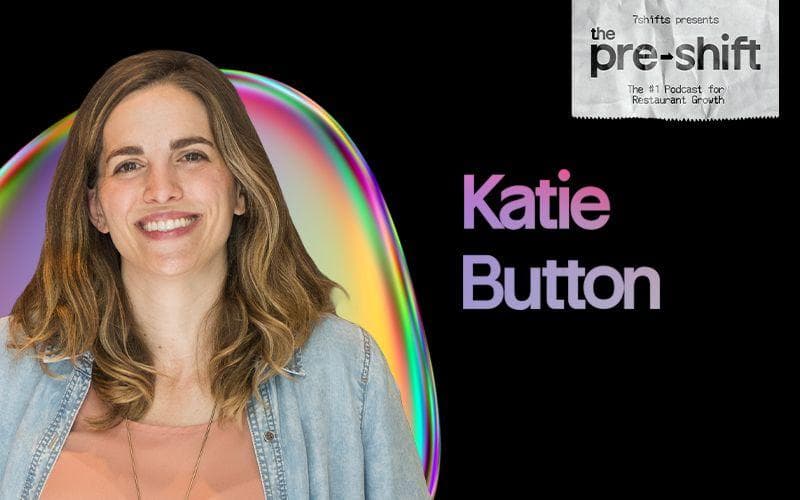Front-of-house and back-of-house teams are equally important in creating a great dining experience—one can’t function without the other. But thanks to the tipping system, it’s usually front-of-house staff who take home significantly more money. So, is that really fair?
On this episode of The Pre-Shift, we sat down with Katie Button, Chef and Founder of Button Meana Group, to discuss bridging the wage gap between restaurant roles. After trading her career in biomedical engineering for hospitality, Katie’s goal is to reshape the industry’s culture by challenging its traditional pay models. She shares insights on fair wages, tip-sharing, and better benefits for all employees.
Listen to the episode
Meet Katie Button, Chef & Founder of Button Meana Group
With a background in biomedical engineering, Katie’s path into the restaurant world was anything but typical. She had plans to pursue a PhD when she suddenly realized: “I wasn’t enjoying what I was doing. It felt like I was on this path for the rest of my life, doing something I didn’t like.” At the time, she was cooking just for fun to get through her studies. So, she made a pivot.
After applying to a few restaurant roles in D.C., she landed a serving position at one of José Andrés’ restaurants. Here, she was introduced to Spanish cooking (and her now husband and business partner, Felix Meana). The two later moved to Spain, where she honed her skills at the legendary elBulli, deepening her expertise in Spanish food.
They eventually settled in Asheville, North Carolina, where they opened their first Spanish restaurant, Cúrate Bar de Tapas, in 2011. Since then, Katie has built her own restaurant group, the Button Meana Group, which includes Cúrate Bar de Tapas and La Bodega by Cúrate. She’s a five-time James Beard Award nominee, a cookbook author, and a media personality—driven by a passion to challenge industry norms.
Breaking down the issues behind the traditional tipping model
While the pandemic was a devastating time for restaurants, for Katie, it also became an opportunity to rethink structure—and reimagine what restaurant jobs could look like. When it was time to reopen, she moved away from the sub-minimum wage model and introduced a tip-sharing system.
The old model had been a long-standing concern for Katie. Under it, front-of-house staff earned just $2.13 an hour, relying on tips to make up the rest. “It puts them very much at the whim and beck and call of whoever the guest happens to be.”
And of course, one of the biggest issues with the traditional system is the extreme wage disparity between service staff and other employees. She explains that a restaurant team is like a ballet—everyone, including the host, prep cooks, and dishwasher, work together to create an amazing experience. “If one piece is missing, the whole house crumbles. We’re feeling this value of each and every individual, but then we’re having a really hard time with the pay structure.”
This is also because paying sub-minimum wage adds a layer of compliance that favors some roles over others: “If you’re going to pay someone $2.13 an hour, then [the front-of-house employee] has to be protected and receive all their tips.”
“It just was really hard to watch some positions work the really hard shifts. Christmas week, for example, is crushing—you’re working as fast as you can, whether you are cooking, prepping, washing dishes, or cleaning. When you’re hustling that hard, it’s because there are more diners sitting down. There’s more work to be done, and therefore, there are more tips. And the only people who were receiving that were a very small number of people, and then the rest were just having to work super hard for a lower hourly wage. It felt like we were saying to our people, ‘You are less valuable.’ And that just really didn’t feel right.”
Transitioning to a tip-sharing model
Katie now operates with a weighted distribution tip-sharing model. “What it means is we apply certain weights to positions. The end goal is to create a path for people through promotion to move up and receive more pay through the positions.”
“We’re able to share tips across the team, but we give a little bit higher tip percentage to those workers who do have the opportunity to sell—our front-of-house servers and bartenders. But, it has still drastically improved from where we were before we implemented this.”
“Now, we’ve coupled that with clear base pay rates and abilities to achieve raises for all the positions that are based on education and training. So in the kitchen, as you learn new stations, that’s how you get potential bumps. And in the front of house, as you learn pass and wine, you get bumps.”
Katie notes that another plus to the tip-sharing model is that there aren’t drastic peaks or drops in earnings due to seasonality. “Because the base wage is so much higher for everybody, it normalizes things for people—they can therefore plan.”
As for her final verdict on making the switch? Katie says, “I would never go back.” In fact, she’d like to move away from tip-sharing altogether—but for now, she’s taking it one step at a time.
Offering extended employee benefits
Outside of pay, Katie also speaks to the importance of offering additional benefits. Before switching to the tip-sharing model, there was also a clear gap here—front-of-house employees who received tips weren’t receiving benefits, since they were already earning so much more.
But now, all employees at the restaurant have access to:
- Health insurance, including dental and vision coverage
- Short-term disability insurance
- Paid time off and sick days, which start accruing immediately
While the health plan is high-deductible, it’s paired with a direct primary care membership—half of which the restaurant covers. “Direct primary care is amazing. For a certain flat rate per month, you get 24/7 access to your physician. We are finding that this is changing the health lives of myself and all of our employees to have this. It gets your normal day-to-day care out of the world of insurance. And then you have this insurance for catastrophic-type situations, which is important.”
And while the rate employees receive for their paid time off is initially based on the local living wage, it’s adjusted to reflect the employee’s average pay—including tips—after their one-year anniversary. Katie explains that this helps give everyone a more accurate picture of what they’d be earning if the restaurant moves away from tips entirely, which is the long-term goal.
She’s also a strong advocate for transparency. Every employee receives a total rewards statement that breaks down:
- Base wage earnings
- Tip earnings
- Hours worked
- Average pay by hour
It also includes details on benefits usage for insurance, PTO, sick days, and 401(k) contributions. “That way, they can see which benefits they’re taking advantage of—and the ones where they’re leaving money on the table.”
They’re also moving to a condensed version with more frequency: “We find that it’s really hard for people who are receiving both a base wage and tipped income together to understand how much money they’re actually bringing in. So, quarterly now, we will give them just a shorter version of that that shows what they’ve made.”
On top of all that, the tip pool is completely transparent, too. “We post the tip pool daily and how it gets split among everybody. It’s this idea that they know they can look through and see all the names of all the people who worked that day. And then, they can also see that it totaled out to the total tips that came in.” It also creates more predictability as employees can see the ebbs and flows of the season.
Adjusting the budget to make high wages possible
While many operators would love to pay higher wages, it’s not as simple as it sounds—and Katie acknowledges that. She worked with the Asheville-based organization, Just Economics, to help calculate the local living wage. “We create a commitment to individuals to ensure that they are earning that amount.”
To fulfill this commitment, she has had to pay close attention to other business areas, like menu prices and food portions. She admits that labor percentages have creeped up (especially with the adoption of more employee benefits), often making it a challenge to keep labor costs below 35%.
Also read: The Restaurant Labor Cost Playbook
But because Katie stands for her values (and for her employees), she explains that it’s all about constant re-evaluation.. But because Katie stands by her values (and her employees), she explains that it’s all about constant re-evaluation. And as a final takeaway: “We haven’t done everything at once.” Katie’s team is taking it one step at a time, continuing to rewrite the traditional divide between front-of-house and back-of-house employees.
Resources
- Connect with Katie Button on LinkedIn ????
- Visit: Cúrate and La Bodega by Cúrate ????️
- 7shifts Restaurant Management Blog ????

Jessica Ho, Content Marketing Specialist
Jessica Ho
Content Marketing Specialist
Hi, I'm Jessica, Content Marketing Specialist at 7shifts! I'm writing about all things related to the restaurant industry.
